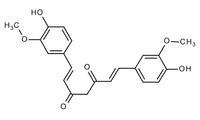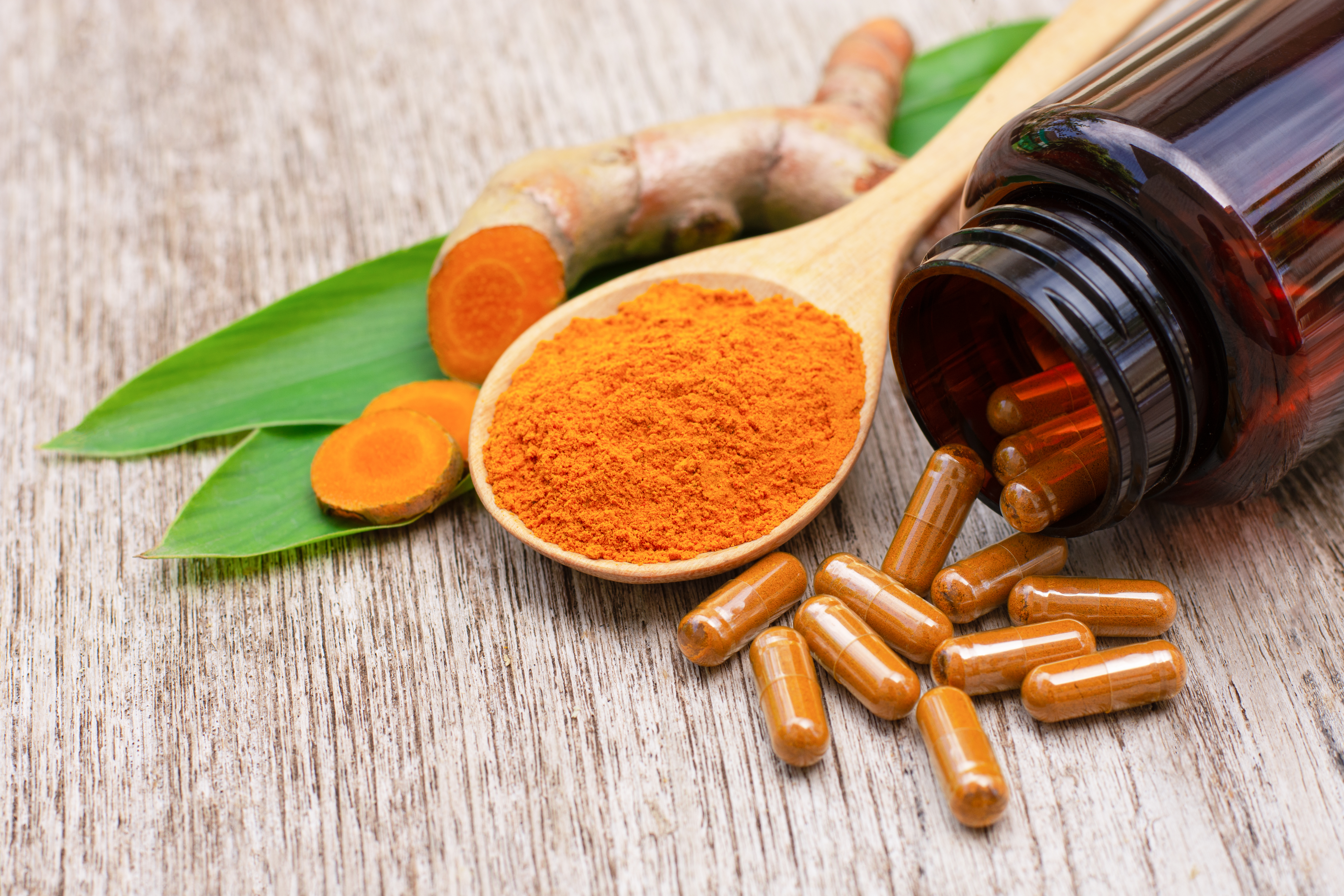INTRODUCTION
Curcumin is a bright yellow chemical produced by plants of the Curcuma longa species. It is the principal curcuminoid of turmeric (Curcuma longa), a member of the ginger family, Zingiberaceae. It is sold as an herbal supplement, cosmetics ingredient, food flavoring, and food coloring.
Chemically, curcumin is a diarylheptanoid, belonging to the group of curcuminoids, which are phenolic pigments responsible for the yellow color of turmeric.
| Synonyms | 1,7-Bis-(4-hydroxy-3-methoxyphenyl)-1,6-heptadiene-3,5-dione Turmeric yellow Diferuloylmethane |
| CAS no. | 458-37-7 |
| EINECS no. | 207-280-5 |
| Molecular formula | C21H20O6 |
| Molecular weight | 368.39 |
| Structure |  |
Applications
Widely used in food, dishes, cakes, candy, canned drinks, cosmetics & medicine coloring.
Some Health Benefits:
| Turmeric contains bioactive compounds with powerful medicinal properties |
| Curcumin is a natural anti-inflammatory compound |
| Dramatically increases the anti-oxidant capacity of the body |
| Boosts brain derived neurotrophic factor, linked to improved brain function and a lower risk of brain diseases |
| Curcumin should lower the risk of heart disease |
| Curcumin can help prevent (and perhaps even treat) cancer |
| Curcumin may be useful in preventing and treating Alzheimer’s disease |
| Arthritis patients respond very well to curcumin supplements |
| Curcumin has incredible benefits against depression |
| Curcumin may help delay aging and fight age related chronic diseases |
| Grades available |
|---|
| 1. Curcumin 95% |
| 2. Curcumin 95% Solvent Free |
| 3. Curcumin 95% Ethanolic Extract |
| 4. Curcumin Water Dispersible 10% & 20% |
SPECIFICATIONS
| Test | Test Method | Specification |
|---|---|---|
| Physicochemical Tests | ||
| Botanical name | – | Curcuma longa |
| Plant part used | – | Rhizome |
| Herb ratio | – | 25:1 |
| Description | Visual | Orange yellow coloured powder |
| Loss on drying at 105°C | USP<731> | NMT 2.0% w/w |
| Assay | ||
| Curcuminoids content | by HPLC | NLT 95% w/w |
| Total Heavy metals | USP<231> | NMT 10 ppm |
| Arsenic | ICP-MS | NMT 1.0 ppm |
| Lead | ICP-MS | NMT 3.0 ppm |
| Mercury | ICP-MS | NMT 0.1 ppm |
| Cadmium | ICP-MS | NMT 1.0 ppm |
| Microbiological analysis | ||
| Total plate count | USP<2021> | NMT 1000 Cfu/gm |
| Yeast & Mould | USP<2021> | NMT 100 Cfu/gm |
| Salmonella | USP<2022> | Absent |
| Escherichia coli | USP<2022> | Absent |
| Staphylococcus aureus | USP<2022> | Absent |
| Pseudomonas aeruginosa | USP<2022> | Absent |
STORAGE
Store in a cool, dry, well – ventilated warehouse. Stay away from fire and heat. Prevent direct sunlight.
PACKING
25 kg drum.
DMF status
Available US-DMF filed with US FDA.
No matter the quantity you need, our exceptional quality and service will make ExSyn your supplier of choice! If you need any additional information or SDS, please contact us.
5-Methyl-3-vinyl-2-oxazolidinone (V-MOX) is a highly reactive monomer valued for its low viscosity, mild odor, and excellent reactivity. It is widely used as a reactive diluent in UV-curable inks and coatings, where it enhances adhesion, produces brighter colors, and improves safety compared to conventional diluents. In addition, V-MOX serves as a key building block in the synthesis of kinetic hydrate inhibitor (KHI) polymers, which are applied in oil and gas production to prevent hydrate blockages in pipelines.
Zinc ricinoleate is the zinc salt of ricinoleic acid, a hydroxylated fatty acid derived mainly from castor oil (Ricinus communis). It appears as a white to slightly yellowish powder, waxy solid, or paste, depending on formulation. Its most valuable property is its ability to trap and absorb odor molecules such as amines, sulfides, and short-chain fatty acids, making it an essential ingredient in deodorant and odor-control products.
2-(tert-Butyl amino)ethyl methacrylate (TBAEMA) is a functional methacrylate monomer that contains a secondary amine group and a hydrophobic tert-butyl moiety, giving it excellent versatility in pH-responsive and adhesion-enhancing polymer systems.
It is valued in printing ink formulations for its ability to enhance adhesion, flexibility, and surface interaction.
Commonly known as potassium bis(fluorosulfonyl)imide (KFSI), the compound has a three-carbon backbone bearing six fluorine atoms and two sulfonimide (-SO₂F) groups. The molecule’s architecture lends it both high chemical stability and useful reactivity. Because of its excellent ionic conductivity and thermal / electrochemical stability, it finds use in advanced electrolyte formulations—for example in lithium-ion and next-generation batteries, in ionic liquids, and in other electrochemical systems.
Colchicine is a naturally occurring alkaloid obtained primarily from the autumn crocus (Colchicum autumnale) and related species. It has been used in medicine for centuries, especially for the treatment of gout and Familial Mediterranean Fever. In modern medicine, Colchicine is valued also in conditions like pericarditis, Behçet’s disease, and certain dermatological and cardiac disorders.
1-Butylimidazole is a versatile organic heterocyclic compound belonging to the imidazole family, where a butyl group (–CH₂–CH₂–CH₂–CH₃) is attached to the nitrogen atom at the 1-position of the imidazole ring. Its applications span organic synthesis, materials science, and bioactive compound development due to its tunable physicochemical properties and structural versatility.
Atropine sulfate monohydrate is a chemical compound, specifically a salt of atropine and sulfuric acid, with one water molecule (monohydrate) attached. It is commonly used as a medication and in research due to its anticholinergic properties, meaning it blocks the effects of acetylcholine at muscarinic receptors.
4-Aminobenzoic acid, commonly abbreviated as PABA, is an aromatic amine and carboxylic acid compound. It consists of a benzene ring substituted with an amino group (–NH₂) in the para position to a carboxylic acid group (–COOH).
2-Amino-5-Nitrophenol (5-NAP) is an organic compound with the molecular formula C₆H₆N₂O₃. It is a substituted phenol with both an amino group (-NH₂) and a nitro group (-NO₂) attached to a benzene ring, along with a hydroxyl group (-OH).
